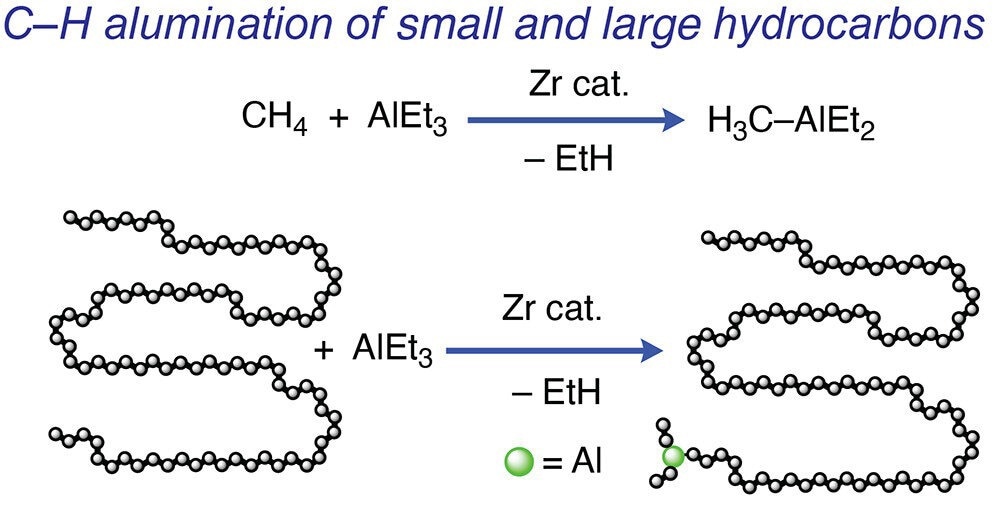In an important step towards a commercially viable green hydrogen industry, researchers have created an economical and more energy-efficient method of producing hydrogen straight from saltwater. The new catalyst converts hydrocarbons into chemicals and materials that are more valuable, simpler to recycle, and more environmentally friendly.

Graphical abstract. Credit: Journal of the American Chemical Society (2023). DOI: 10.1021/jacs.2c11056
This catalyst changes materials like motor oil, plastics used in single-use shopping bags, the caps on water or milk bottles, and even natural gas. Ames National Laboratory scientist Aaron Sadow, who also serves as director of the Center for Cooperative Upcycling of Plastic (iCOUP) and a Professor of Chemistry at Iowa State University, led the group.
The goal of the novel catalyst is to give functional groups to aliphatic hydrocarbons. Aliphatic hydrocarbons are organic compounds that exclusively include carbon and hydrogen. Since they lack functional groups, they normally do not mix with water and instead form distinct layers.
Atoms within molecules can be arranged into functional groups, each with distinct properties. These hydrocarbon chains can be given functional groups to significantly alter their characteristics and make the materials reusable.
Methane in natural gas is the simplest of hydrocarbons with nothing but carbon-hydrogen (CH) bonds. Oils and polymers have chains of carbon atoms, linked by carbon-carbon (CC) bonds.
Aaron Sadow, Scientist, Ames National Laboratory
Most petroleum and refined petroleum products, including plastics and motor oils, are made mainly of aliphatic hydrocarbons.
Sadow added, “These materials don’t have other functional groups, which means they are not easy to biodegrade. So, it has long been a goal in the field of catalysis to be able to take these kinds of materials and add other atoms, such as oxygen, or build new structures from these simple chemicals.”
However, adding atoms to hydrocarbon chains in a conventional manner consumes a lot of energy. Initially, small building blocks of petroleum are “cracked” with heat and pressure. After that, chains are created using those building blocks.
At the very end of the chains, the desired atoms are finally added. This innovative method converts existing aliphatic hydrocarbons directly, at low temperatures, without breaking.
The CC bonds in these hydrocarbon chains were previously broken by Sadow’s team using a catalyst while simultaneously attaching aluminum to the ends of the smaller chains. They then created functional groups by inserting oxygen or other atoms. The team discovered a technique to skip the CC bond-breaking phase and created a complimentary procedure.
“Depending on the starting material’s chain length and the desired properties of the product, we might want to shorten chains or simply add the oxygen functional group. If we could avoid the CC cleavage, we could, in principle, just transfer the chains from the catalyst to aluminum and then add air to install the functional group,” Sadow further stated.
According to Sadow, the catalyst is created by bonding a commercially available zirconium compound to commercially available silica-alumina. The materials are all affordable and readily available on Earth, which is advantageous for future commercial uses.
The catalyst and reactant are also favorable in terms of cost and sustainability. The most common metal on Earth is aluminum, and the aluminum reactant employed in its synthesis does not produce any unwanted by-products. The precursor zirconium alkoxide-based catalyst is air-stable, easily accessible, and reactor-activated.
Sadow stated, “So unlike a lot of early organometallic chemistry that is extremely air sensitive, this catalyst precursor is easy to handle.”
This chemistry is a stride towards being able to modify the physical properties of different plastics, such as making them more durable and customizable.
Sadow further added, “As we develop the catalysis more, we expect that we will be able to incorporate more and more functional groups to affect the physical properties of the polymers.”
The collaborative nature of iCOUP, according to Sadow, is what made this initiative successful. Using Nuclear Magnetic Resonance (NMR) spectroscopy, Perras’ team at Ames National Laboratory investigated catalyst structures.
The research groups of Coates, LaPointe, and Delferro from Cornell University and Argonne National Laboratory examined the structural and physical characteristics of polymers. A statistical model of polymer functionalization was also developed by Peters’ team at the University of Illinois.
“Project successes in the center build on contributions of many groups’ expertise. This work highlights the benefits of team science,” Sadow added.
Further information on this study is provided in the article “Zirconium-Catalyzed C-H Alumination of Polyolefins, Paraffins, and Methane,” written by Uddhav Kanbur, Alexander L. Paterson, Jessica Rodriguez, Andrew L. Kocen, Ryan Yappert, Ryan A. Hackler, Yi-Yu Wang, Baron Peters, Massimiliano Delferro, Anne M. LaPointe, Geoffrey W. Coates, Frédéric A. Perras, and Aaron D. Sadow.
Also, the project was highlighted in JACS Spotlight with the title “A Flexible New Tool for Producing Commodity Chemicals.”
The Institute for Cooperative Upcycling of Plastics (iCOUP), under the direction of Ames National Laboratory, carried out the study.
Scientists from the University of Illinois Urbana-Champaign, UC Santa Barbara, University of South Carolina, Cornell University, Northwestern University, and Argonne National Laboratory make up the Energy Frontier Research Center known as iCOUP.
Journal Reference:
Kanbur, U., et al. (2023) Zirconium-Catalyzed C–H Alumination of Polyolefins, Paraffins, and Methane. Journal of the American Chemical Society. doi:10.1021/jacs.2c11056